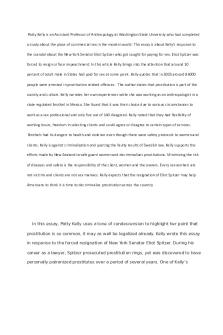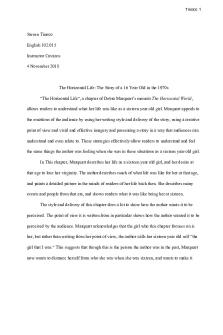English 250 Visual Rhetorical Analysis Worksheet 2 PDF

| Title | English 250 Visual Rhetorical Analysis Worksheet 2 |
|---|---|
| Course | Written, Oral, Visual, and Electronic Composition |
| Institution | Iowa State University |
| Pages | 5 |
| File Size | 150.1 KB |
| File Type | |
| Total Downloads | 38 |
| Total Views | 121 |
Summary
ENG 250...
Description
English 250, Week 6 Worksheet 2: Practicing Visual Rhetorical Analysis [NOTE: Refer to pages 329-333 in Everything’s an Argument for additional detailed questions.] I. Visual message/purpose. What can you gather about:
Context--background of creator/source: o Gucci is an Italian fashion and leather goods brand, part of the Gucci Group, which is owned by French company Kering formerly known as PPR. Gucci was founded by Guccio Gucci in Florence in 1921. They are well known for their fragrances and designer items and accessories.
Audience/viewers that it hopes to reach: o The audience/viewers that this ad is intended for is any adult audience that wants to
Purpose/ content: o The purpose of the content is to sell the perfume and cologne. The means of doing this is to appeal to the seductive senses of the audience. Medium: o Cosmopolitan magazine. The black and white, use of contrast, simplistic style, catchy perfume title.
desirable, alluring, seductive, etc.
II. Design/Visual Structure A. Generally… What is my eye drawn to first? Second? Why? The eye is immediately drawn to the vuluptuois red lips then the two perfume bottles. This is because the ad is in black and white minus the lips and bottles.
Is the image realistic (i.e. photograph), stylized (i.e.cartoon), or abstract (neither realistic nor stylized—uses color, shape, lines and layout)? The image is realistic because it uses a photograph of two seductive models. What is the overall, general impression? The overall impression is that the perfume Gucci guilty must make you sexier. Therefore, a reader that desires this would want to buy the product. B. Visual message and structure (See Student Guide pp. 45-49, EW Ch. 9, and EA Ch.14.): 1. Pattern Do I see consistency, variety, balance? The consistency in this ad includes the use of symmetry with both perfumes on either bottom corner of the page as well as the two faces split down the middle representing the mens and womens versions of the Gucci guilty. The variety includes the two objects, the red lips and that’s about it. The balance is the symmetry of the man and women and weight of the two bottles in the foreground. Can I identify the grid?
Yes, the grid is identifiable based on the size of the bottles. 2. Contrast Focal point(s): What is my eye drawn to, and how is it guided? White/negative space? My eye is immediately drawn to the red lips and the bottles. The negative space may be the black and white picture. Color? The pop of color is the red lips and the slight pops of color are the two bottles. Foreground and background: What is in each and how is that achieved? The foreground contains the bottles which shows that the ad is trying to sell but the background is the seductive picture of the couple which is trying to put in the subconscious that the perfume will make you alluring. Dimensionality: 3? 2? The image is three dimensional with the shading and bottles in the front. 3. Direction Where/how do the lines lead us? (diagonals, curves, rectilinear) The curves and lines aren’t very precise or relevant and don’t relate much because the picture is simple and doesn’t have a lot going on. Is there repetition, suggesting more movement? Is there repetition of key words, elements (typeface, color, images) I don’t see the repetition in the simple ad. Are my eyes directed, settled, confused? My eyes are directed on the red lips and settled on the perfumes. Alignment –left, right, center? Is it organized? The alignment is left and right and centered. The bottles on left and right and image and title centered. 4. Chunking --Information is ‘chunked’ into small units to match limited human short-term memory (Harvard psychologist George Miller’s discovery) Are there 5-9 parts or fewer? yes Can you identify the parts of the information clearly? First bottle, second bottles, lips and maybe title. Do the number of ‘chunks’ decrease if message is more complex? no Proximity—Are ideas that go together, clustered together? Are there clear headings? The single heading is clear. 5. Color: How do the following help accomplish the purpose or convey the message in the visual argument? (See p.49 SG)
Hue – red, yellow, neutral, etc. Simple pop of red Intensity/brightness-- high-low The red is intense and the shades and black/white is subdued Value--lightness or darkness/contrast Grayscale is used for the background and sharp colors and lighting is used for the important bottles and title. III. Argument Tactics and Fallacies: Can you identify any argument tactics used or possible fallacies of argument in this visual argument? See list of fallacies below and explanations/examples in your texts. Remember, sometimes the creator and viewer of an argument will see a given strategy differently: The creator may see it as a reasonable tactic to make his/her argument (or a sneaky fallacy but does not care), and the viewer may see it as a fallacy or a legitimate argument tactic. [Note: Refer to EA: Ch. 5, pp. 75-88 and EW: Ch.13, pp. 151-155 for detailed explanation of fallacies.] 1. Scare Tactics The reader isn’t scared really. 2. Either-Or (oversimplify a complex issue, reducing it to two options) This is a very simple request… not an issue but a choice. 3. Slippery Slope Possibly that if u don’t buy this product you wont be seductive 4. Overly sentimental appeal (distract from facts) This is appealing to your sense of desire which perfume cant actually do. 5. Bandwagon Appeals (“everyone else does or thinks this”) Everyone wants to feel sexy 6. Appeal to False Authority (one authority or author himself is sufficient to make a claim) This will make u feel alluring 7. Dogmatism (there is only one position conceivable) none 8. Ad Hominem (= ‘to the man’ in Latin; attacks the person instead of the argument) Not an attack 9. Guilt by association (linking a person to a group or stance of ill repute) none 10. Flattery (persuade readers by flattering them) Flattering the sense of sexuality of the reader 11. In-Crowd Appeal (hopes readers will identify themselves with a select, admired group— also flattery.) Reader wants to be sexy like the other Gucci guilty wearers 12. Veiled threat (Readers will suffer consequences if they don’t agree) If you don’t buy this you wont be desired 13. Stacking the Deck (reveals only one side of the data or argument) none
14. False/Faulty Analogy (creator draws an analogy comparing two items that differ in key aspects) Analogy between perfume and sexual appeal 15. Hasty Generalization (a conclusion or inference is drawn based on insufficient evidence; steps are skipped in this logical fallacy) none 16. Begging the question (circular thinking which assumes the original statement is true) none 17. Post Hoc Fallacy (Faulty Causality) – Latin: post hoc, ergo propter hoc = “after this; therefore, because of this.” In other words, because one event followed another, the first event caused it. none 18. Non Sequitur (Latin: it does not follow) One claim does not logically connect with the other. Sexiness and perfume 19. Equivocation—A half-truth which gives a lie or partial lie an honest appearance. See above 20. Oversimplification Yes, sexy=perfume 21. Straw Man--Build a false or misrepresented view of the opposition; then shoot it down. (It is an argument that was never really there.) none 22. Red Herring – Use a distraction to set up an argument. (See EA p. 87) none 23. Visual Fallacies: Misleading photographs slightly Misleading charts and graphs (See example in EW p. 154-155) no
IV. Overall Impression and Success of Argument: Is the message consistent? Clear? Confusing? Pleasing? Desirable? Appealing to logos, pathos or ethos in some way? Yes, very pleasing and desirable and appeals in the emotion to be sexy. How does the general format facilitate the purpose/message? The message is very clear and simple and represented well. Does the creator successfully achieve his/her purpose for the intended audience? How, why, or why not? (You may have answered some of these in previous questions.) yes because the red lips give the appeal of sexiness and the perfumes are clear and the purpose is clear.
V. Thesis. After carefully considering your answers to the above questions, begin to formulate the thesis for your visual rhetorical analysis below. Answer this guiding question in your thesis: What argument does the creator present, and how/how well does he/she do it? (Focus on the techniques/strategies that are used to accomplish the likely intent.) Thesis: Through the magazine Cosmopolitan, Gucci efficiently convinces the viewer to purchase their “Gucci Guilty” cologne and perfume by appealing to the viewers desire to be alluring and seductive as well as utilizing a simplistic visual contrast, color and pattern....
Similar Free PDFs

Visual Analysis Worksheet 2
- 2 Pages

Rhetorical Analysis
- 5 Pages

Rhetorical analysis
- 2 Pages

Puppy Rhetorical Analysis
- 4 Pages

Rhetorical analysis -1
- 4 Pages

Bowling Dana Rhetorical Analysis
- 4 Pages

Rhetorical Analysis Essay
- 5 Pages

Textual Rhetorical Analysis
- 3 Pages

Rhetorical Analysis Final
- 5 Pages

Rhetorical Analysis Prompt
- 2 Pages

Final Rhetorical Analysis Essay
- 2 Pages
Popular Institutions
- Tinajero National High School - Annex
- Politeknik Caltex Riau
- Yokohama City University
- SGT University
- University of Al-Qadisiyah
- Divine Word College of Vigan
- Techniek College Rotterdam
- Universidade de Santiago
- Universiti Teknologi MARA Cawangan Johor Kampus Pasir Gudang
- Poltekkes Kemenkes Yogyakarta
- Baguio City National High School
- Colegio san marcos
- preparatoria uno
- Centro de Bachillerato Tecnológico Industrial y de Servicios No. 107
- Dalian Maritime University
- Quang Trung Secondary School
- Colegio Tecnológico en Informática
- Corporación Regional de Educación Superior
- Grupo CEDVA
- Dar Al Uloom University
- Centro de Estudios Preuniversitarios de la Universidad Nacional de Ingeniería
- 上智大学
- Aakash International School, Nuna Majara
- San Felipe Neri Catholic School
- Kang Chiao International School - New Taipei City
- Misamis Occidental National High School
- Institución Educativa Escuela Normal Juan Ladrilleros
- Kolehiyo ng Pantukan
- Batanes State College
- Instituto Continental
- Sekolah Menengah Kejuruan Kesehatan Kaltara (Tarakan)
- Colegio de La Inmaculada Concepcion - Cebu




